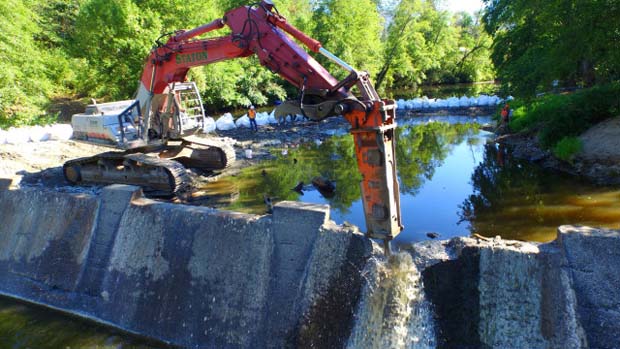Dam Removal in Southern Oregon Opens Up 70 Miles Of Salmon and Steelhead Habitat
Story by Jes Burns – EarthFix / August, 2015
[dropcap]E[/dropcap]vans Creek is barely a trickle. A dry summer in Southern Oregon means the important salmon and steelhead creek, a tributary of the Rogue River, disappears below the gravel bed in places. Seemingly stagnant isolated pools are all that remain in some areas.
Normally, this wouldn’t be considered a good thing. But right now, Brian Barr, dam removal project manager for the GEOS Institute, will take it.
“Believe it or not, we got lucky from the perspective of not having a lot of water,” he said. “We’re in the middle of the second year of a really bad drought here in Southern Oregon, and it just happens to be the year that we’re constructing.”
By “constructing,” he actually means demolishing the Wimer and Fielder dams. These dams were both constructed as irrigation diversions in the early 1900s.
Barr said managing water is perhaps the most challenging aspect of any dam removal project.
“Water is an incredibly powerful force,” he said. “Any time you doubt that you just have to look at the Grand Canyon and see what running water can do when you let it run for a little while.”
Of course the lack of water is not a complete windfall for construction crews. It’s creating some problems of its own — namely that there’s not enough flow to flush sediment that gets stirred up during construction downstream. Turbidity has been higher than hoped, and workers have been forced to limit in-stream work to about four hours a day to keep levels within permitted range.

Demolition crews knock out first notch in Wimer Dam on Evans Creek, a tributary of the Rogue River.
River Design Group
‘Butter Knife’ Demolition
The Wimer Dam is about 9 miles upstream of where Evans Creek hits the Rogue River. Crews are removing the 11 foot tall, 150 foot wide concrete structure — but not with anything dramatic like explosives. Instead, the chosen demolition method is a giant jackhammer.
“Most dams don’t go in a puff of smoke with a giant stream of chocolate milk coming out the downstream side,” Barr said, referring to the spectacular use of explosives a few years back at the Condit Dam in Washington.
“Usually you very carefully route water around or through the structure and then you slowly and methodically, like with a dull butter knife, take the concrete down and gently on the side of the bank and into a dump truck,” he said.
Fielder Dam, a larger structure closer to the Evans Creek confluence with the Rogue, will be removed in a similar way to the Wimer Dam.
Crews will build a cofferdam, a temporary structure used to route flow out of reservoir water to one side of the dam. Then they can start jackhammering away at the concrete face. Once one side is removed, the coffer will be switched around and the remaining structure will be removed.
The work is slow, and a bit tedious, but the end result will make a huge difference for fish passage.


